Steppe garden evangelist Panayoti Kelaidis’s garden: Denver Garden Bloggers Fling

Despite its Mile High City moniker, Denver is not a mountain town. True, the snow-capped peaks of the Rockies loom on its western horizon, but Denver sits on a relatively flat, semi-arid, grassy plain — aka a steppe, one of the 4 vast steppe ecosystems in the world.
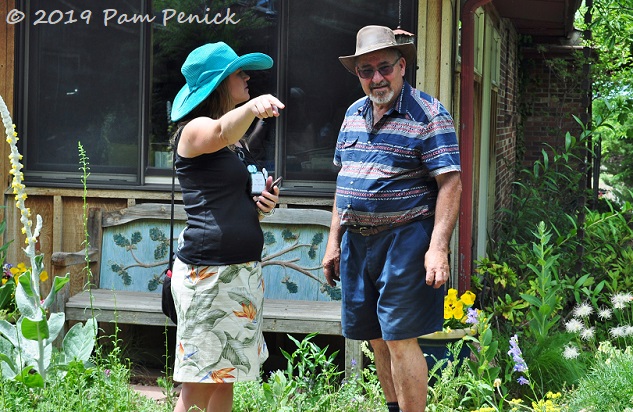
Boulder-native Panayoti Kelaidis, a world-traveling plant explorer, author, nationally known speaker, entertaining blogger at Prairiebreak, and senior curator and outreach director at Denver Botanic Gardens, has made it his life’s work to open people’s eyes to the beauty and value of the steppe’s unique flora. Among his other achievements, he designed the plantings of the superb Rock Alpine Garden at DBG and co-authored the book Steppes.

During the Denver Garden Bloggers Fling (June 2019), we toured his personal garden, a half-acre suburban plot perched on a hillside with a view of the Rockies. Rock garden planters along the front walk set the scene as you enter.
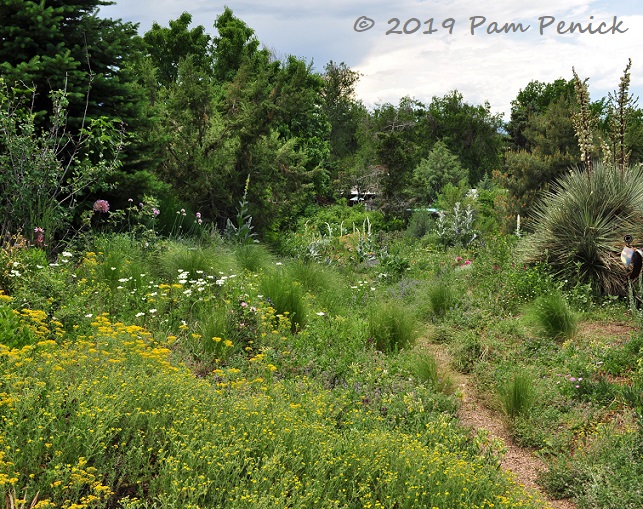
And then you single-file your way through a golden meadow edged with conifers, following a narrow gravel track past bristle-headed Yucca elata, yellow-flowering Ajuga chia, and furry white spires of giant Turkish mullein (Verbascum bombyciferum).
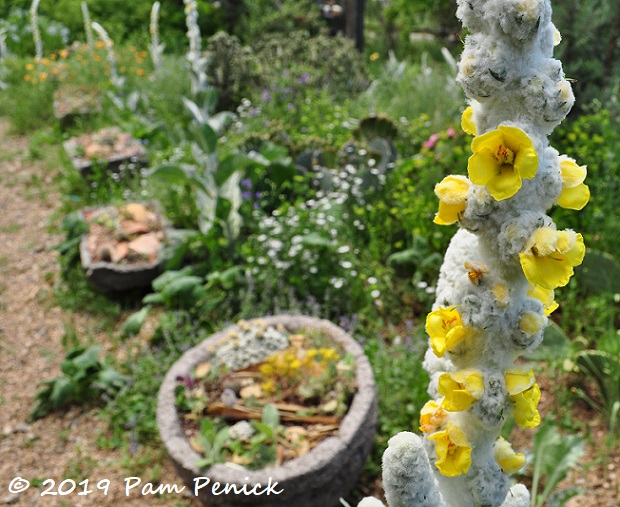
Giant mullein, its yellow-flowering bloom spike cobwebbed with white hairs, dances down the hill path. Squat hypertufa troughs edge the path more substantially, creating a visual rhythm.

Yucca elata in bloom and a steampunk garden figure

Flowering prickly pear lounges like an odalisque along the path.

Those flowers! As beautiful as a peony, and springing from such an inhospitable-looking plant.
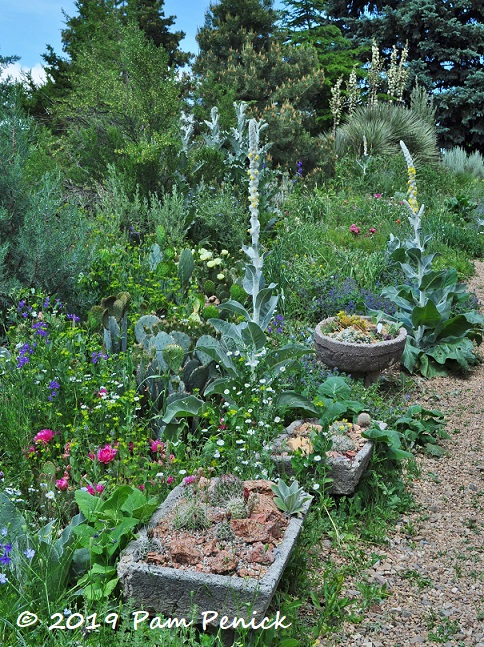
Looking uphill, you enjoy a different perspective, with candle-like bloom spikes standing tall above you.


Woolly silvers and grays are reminiscent of a Central Texas garden.

At the low end of the garden stand more mullein spikes and orange grand-flowered horned poppy (Glaucium grandiflorum). Much of Panayoti’s garden receives no supplemental irrigation, being comprised of dry-loving perennials and annuals. The trade-off in a semi-arid climate like Denver’s is that flowering occurs in a flash — between March and June, he says — and then the garden goes quiet. That’s when structural yuccas and tapestry plants like small succulents really pull their weight.

In a vegetable garden, red orach and red amaranth glow like banked coals behind orange horned poppies.

Hot and cool, orange and silver-white. Horned poppy is a new fave of mine.


A smoky blue fence in the background complements the orange flowers and red foliage, just like the blue fence in Lori Daul’s Garden of Good and Evil here in Austin.

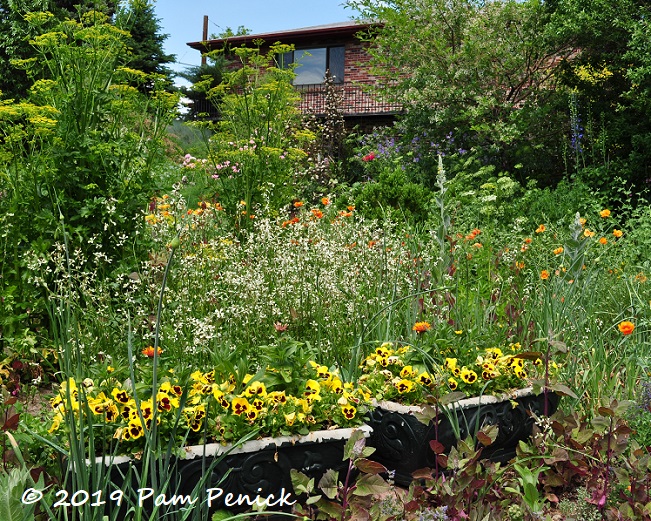
Trough planters filled with sunny pansies add a little structure and a lot of color in front of a meadowy bed.
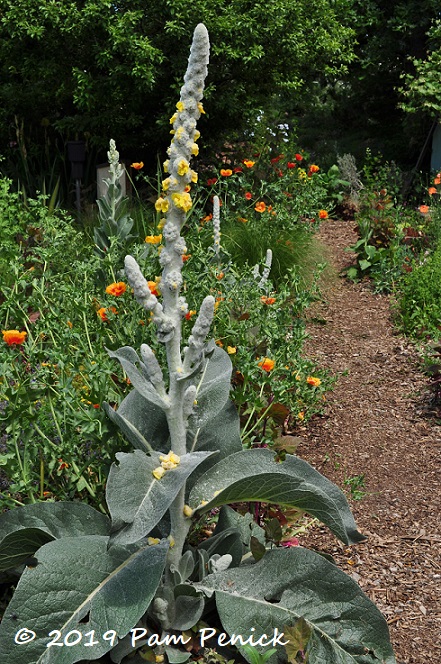
Panayoti calls mullein his “signature weed.” I’d like it to be mine as well. And yes, it can be weedy as it seeds itself into gravel paths and crevices. But how can you resist those velvety silver leaves and furry yellow bloom spikes?

A bee hotel caters to native bees in a shady nook.

Trough planters pop up along paths and patios.

As you follow the path back uphill, now on the other side of the house, a layered, red-rock “mountain” rises before you.

Between the layered stones, alpine plants cling to crevices and spill over the rock like slow-motion waterfalls. Perhaps an actual waterfall once flowed through the slot in the center of the wall, spilling into a small pool at the base, which is just out of view in this photo.

Facing the opposite way, you see a flower border encircling a small lawn pointing like the prow of a ship toward the distant mountains.

The garden climbs up to yet another level from the terrace, accessed on one side via a rustic stair winding between tall trees. The shade garden is a welcome discovery on a warm day.
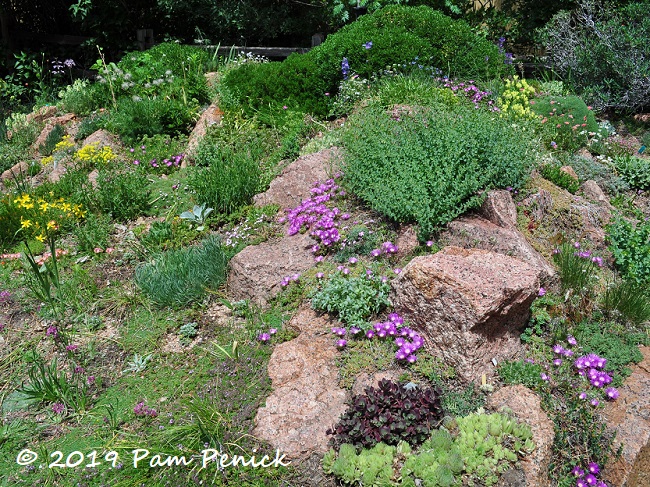
At the top, you’re rewarded with a humped, plant-cushioned rock garden in colorful bloom.

Panayoti grows 1,000 kinds of plants in his rock garden, including many rare species he’s hunted down from all over the world. I confess that the thrill of spotting a rare or unusual species is generally lost on me. But I greatly enjoy seeing how plants, rare or not, combine under the gardener’s artistic eye with rock, hardscaping, and art to create a one-of-a-kind scene that tells their story.

And Panayoti’s garden tells a fascinating story of wanderlust and plant exploration — and an embrace of Colorado’s challenging gardening conditions.
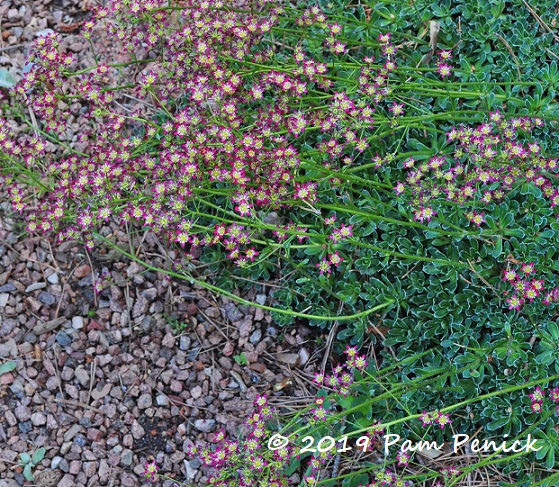

Lily power!


Circling back around, here’s the view from the top of the red-rock “mountain” — i.e., the crevice wall. The narrow stone stair leads down to the patio and the lawn garden.
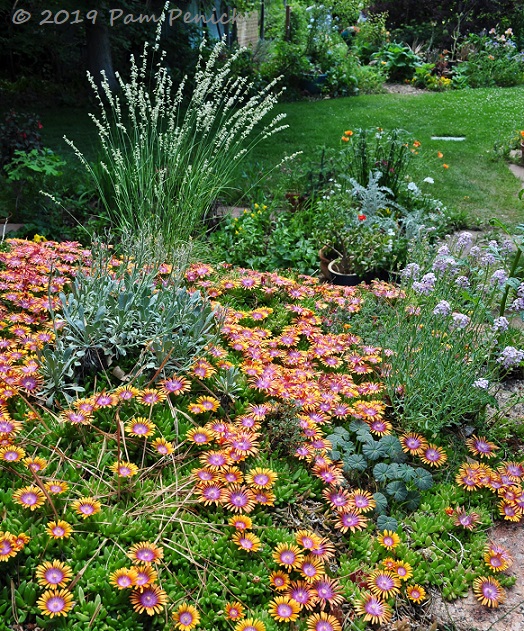
Magical moments abound in Panayoti’s garden.

If you don’t know his work, check out his blog Prairiebreak to follow his plant explorations around the world and perhaps become a convert of steppe gardens yourself.
Up next: The colorful and creative garden of Dan Johnson. For a look back at the Children’s Garden at Denver Botanic Gardens, click here.
__________________________
Digging Deeper
Come learn about gardening and design at Garden Spark! I organize in-person talks by inspiring designers, landscape architects, authors, and gardeners a few times a year in Austin. These are limited-attendance events that sell out quickly, so join the Garden Spark email list to be notified in advance; simply click this link and ask to be added. Season 8 kicks off in fall 2024. Stay tuned for more info!
All material © 2024 by Pam Penick for Digging. Unauthorized reproduction prohibited.


I feel so lucky to have seen Panayoti’s garden at such a lovely time of the season. It is a triumph of plantsmanship and his great passion for horticulture. Your blog captured it beautifully Pam.
Thanks, Janet. I’d like to direct readers to your own terrific post about Panayoti’s garden: http://www.thepaintboxgarden.com/visiting-panayotis-garden/
Your generous blog made me blush: you and Janet both captured features of my garden I hadn’t noticed and flatter me (and my handiwork) with your astute observations and commentary.
I know that you had more than a little to do with bringing the Bloggers: I am deeply gratefu that you did: I was so frantic to get things ready for you, I neglected the opportunity to really join in more of the fun!
Should you return, I shan’t miss that chance!
See you in Texas perhaps this November!
I’d love to visit with you in Texas, Panayoti. Thank you again for sharing your garden with us! As for the tour itself, that was all due to the herculean efforts of the Denver team led by Judy. She and her team deserve heaps of applause for putting on a great tour.
What a great post about Panayoti and the whole steppe garden concept. I simply do not understand how you got so many photos without people in them! Impressive photos as well. Between yours and Janet’s post, the big picture is clearer to me. I thank you guys for that!
Panayoti calls Verbascum his “signature weed”…love it!
You wrote: “I simply do not understand how you got so many photos without people in them!”
I was out of the bus like a shot, Alyse, and got on that downhill path before the crowd arrived. Other than that it’s all about strategic waiting until there’s a clear moment for a photo or lagging at the rear of the pack and shooting back the way we came. Tricks of the Fling trade – ha!
I follow his blog. It is fascinating. A different world than I am used to. He is a great writer too. He brings this type of gardening alive. Well done Pam. I was really looking forward to seeing and reading about his garden through your eyes and lens. I will also check out the blog you mentioned.
He is certainly a good writer who brings obsessiveness about plants to vibrant life. 🙂 I’m glad you enjoyed the post.
Pam, such a wonderful post of one of the gardens I most looked forward to seeing on the fling. Great info too, on the steppe ecosystem and that March thru June flowering peak. If I may be so bold, I do have some “positive criticism” as far as touring gardens like this one. That narrow path from which we entered the garden became a parking lot, as the earliest bloggers to enter stopped for photos along the path, crouching down for the perfect closeups, etc. while the rest of us waited to enter as the timer ticked away for the entire visit. Some tried to dive down a side path where prickly pear grew to avoid the traffic jam, but we were reminded that it was a dead end. I say this with love! It was a fabulous fling! The excitement over seeing this garden may have contributed to my frustration. But I wish everyone simply entered the garden and fanned out and then returned for whatever photos they desired. And thanks so much for the link to Janet’s post — heading there now.
I was very eager to see this garden too, Denise, and was no doubt one of the front photographers slowing the rest of you down. Sorry about that! I agree that in gardens with one path, it’s helpful if half the group can be sent in one direction while the other half goes around the back way, even if it’s not the preferred approach. I’ll pass your helpful constructive criticism along to next year’s planners.
Pam, if that was you ahead slowing us down, these photos are so worth it! Amazing mid-day photography.
You are kind to say so, Denise. I’m just glad no one got hurt diving into prickly pear paths! 😉
Thanks for sharing the tour of this wonderful, dynamic garden. A “slow-motion waterfall” is the perfect description for the flowering plants spilling over the stacked stone wall.
My pleasure, Kris!
Mullein abounds here in NW Ohio! I’ve read that their seed remains viable in the ground for 200 years. Not sure if it’s true or not, but it pops up here ALL the time. Occasionally, I’ll let them grow. Currently, I’ve got one that’s taller than I am that’s beginning to bloom. Seeing them in Denver gave me a new appreciation for them!
I felt so fortunate to get to see Panayoti’s garden and to meet him. He’s such a rock star in the gardening world! You captured his garden perfectly.
I did find a couple of sites that state this:
“Common mullein reproduces and spreads by seeds. It is a prolific seed producer; large mature plants can produce up to 240,000 seeds per year that remain viable in the soil for more than 100 years.”
(https://agfaxweedsolutions.com/2018/06/14/invasive-weeds-common-mullein-mature-plant-240000-seeds-annually)
This is why it’s good to always look up a plant on the invasive plant list for your own region before planting.
Thanks, Kylee! I have a few mullein that return from seed in my gravel path along the driveway. I pull up most but always leave a few.